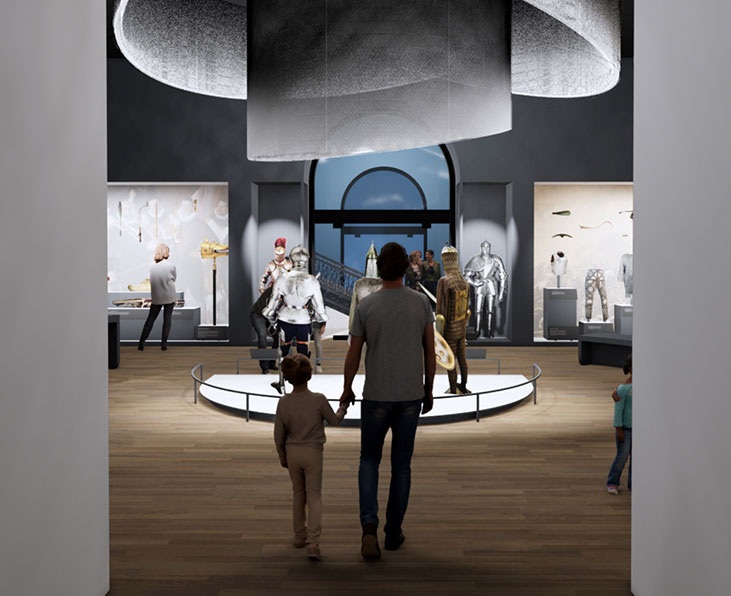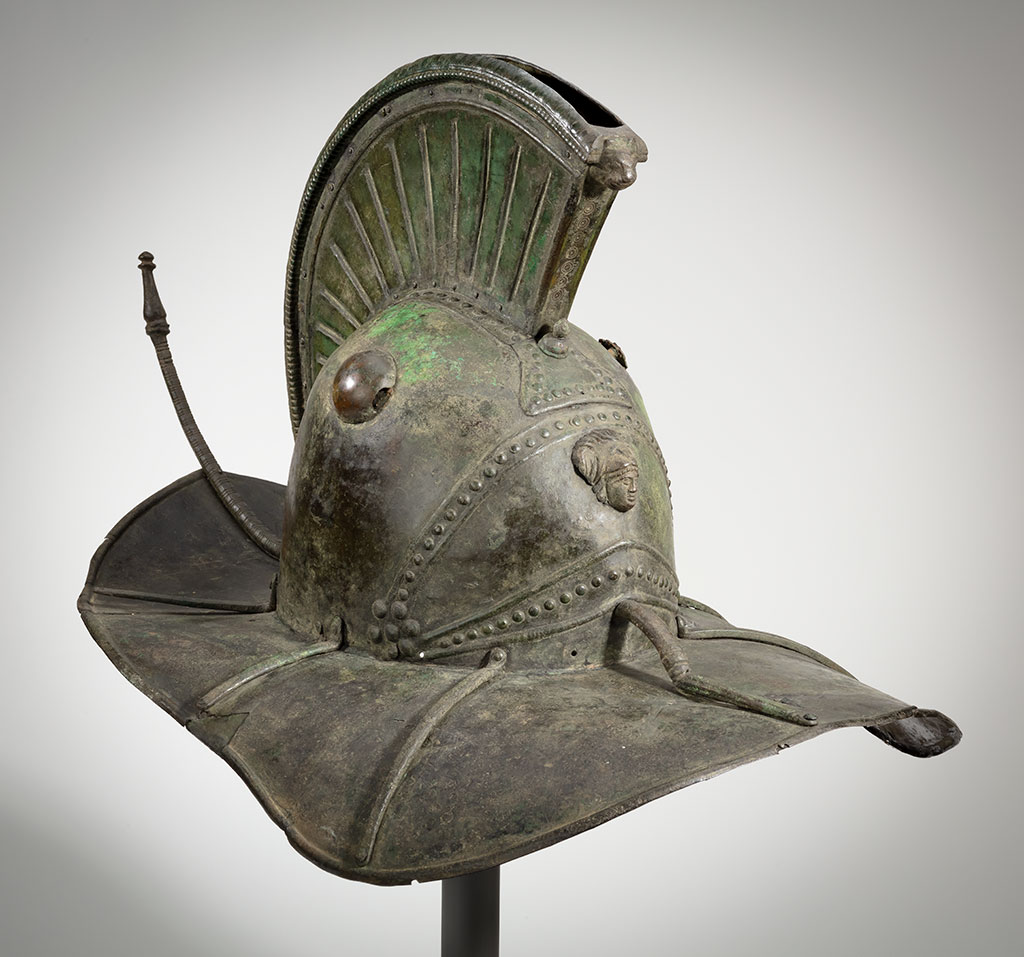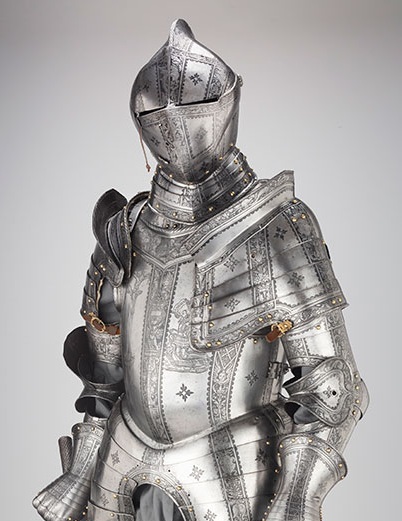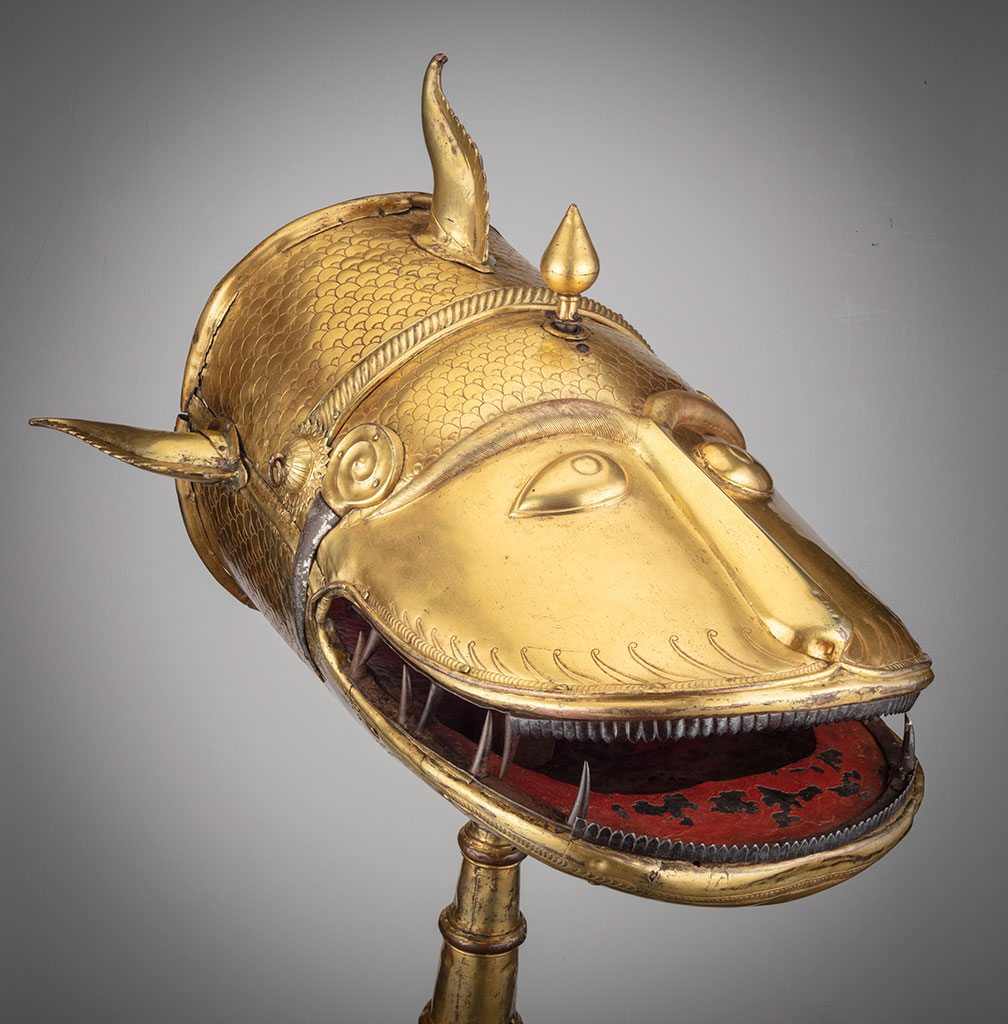Opening November 22, These Newly Created Galleries Are an Innovative Presentation of This Remarkable, Global Collection of Arms And Armor from the Ancient World to the 19th Century

Worcester, MA—August 19, 2025—This November, the Worcester Art Museum (WAM) will open its new Arms and Armor Galleries, presenting this collection—the second largest of its kind in the United States—in a specially designed, 5,000-square-foot gallery space. Centrally located on the Museum’s second floor, these new galleries will present more than 1,000 objects—from medieval and Renaissance Europe to pieces from Greece, Egypt, Japan, India, and beyond—and will showcase the remarkable global and historical breadth of this collection, one of the finest of its kind in the world.
The new galleries are divided into two spacious halls. Upon entering the front gallery, audiences will engage with dramatic arms and armor displays with star objects from the collection. A central platform sets the stage, with three main armor displays representing different cultures and time periods: a Sudanese warrior ensemble from the 1800s, including a helmet, mail coat, spear, and sword; a battlefield armor from Southern Germany, 1525–1530, a 64-pound suit designed to imitate the fashionable pleated fabrics of nobility; and ceremonial armor from Northern India, from the late 1700s–1800s, which features distinctive Ganga-Jamni patterning combining iron and brass links.
Surrounding this installation are a series of table cases, wall cases, and presentation arches, focused on different components of arms and armor, including:
 Helmets, such as a Roman gladiator helmet from 100 CE, and a 17th-century Japanese helmet in a rare conch shell design, likely made for a warlord or general and reflecting the conch shell’s role as a symbol of wealth and authority
Helmets, such as a Roman gladiator helmet from 100 CE, and a 17th-century Japanese helmet in a rare conch shell design, likely made for a warlord or general and reflecting the conch shell’s role as a symbol of wealth and authority
- Ceremonial weapons, including a folding spetum from 16th-century Milan, an ingenious hinged spear that folds in half with automatic blade deployment; and a rare, 15th-century German crossbow decorated with a parchment covering that looks like snake skin
- Shields, including a lightweight Ethiopian shield from the late 1800s-early 1900s made of molded hippopotamus hide; a ceremonial shield from late-1800s Queensland, decorated with sacred images representing bean pods; and a heavy, 18-pound German shield from 1600–1610, designed to protect against firearms
 Suits of armor, such as the armor for Count Franz von Teuffenbach (1516–1578), a full, 57-pound suit of steel designed for both battlefield and tournament use; as well as a gold-pinstriped 66-pound suit of jousting armor, made for a 1618 tournament in honor of Duke Johann Philipp von Weimar (1597–1639),
Suits of armor, such as the armor for Count Franz von Teuffenbach (1516–1578), a full, 57-pound suit of steel designed for both battlefield and tournament use; as well as a gold-pinstriped 66-pound suit of jousting armor, made for a 1618 tournament in honor of Duke Johann Philipp von Weimar (1597–1639),  Partial body armor, like an Indian cuirass from the 1600s, demonstrating the influence of European fashion with embossed pectoral muscles in the steel; and Iranian leg armor from the mid- to late-19th century, made as ceremonial gear and decorated with hunting scenes
Partial body armor, like an Indian cuirass from the 1600s, demonstrating the influence of European fashion with embossed pectoral muscles in the steel; and Iranian leg armor from the mid- to late-19th century, made as ceremonial gear and decorated with hunting scenes
- And an array of battle and fighting components, including the striking standard in the design of a fish head (Mahi-Maratib) from southern India around 1700;o a Japanese hand cannon from the early 1800s, a 126-pound ceremonial weapon with a poetic inscription calling it a “Mountain Piercing Gun;” and unique Indian weapon forms like a katar (punch dagger) and a pata (gauntlet sword).
“The Arms and Armor collection at the Worcester Art Museum is truly a global one, and we want visitors to immediately see and understand the scope of the collection as well as the diversity of how different cultures and communities thought about these objects,” said Jeffrey L. Forgeng, The Higgins Curator of Arms and Armor and Medieval Art at WAM. “Armor and arms continue to have a mythic power, from ancient history to present-day storytelling, and this resonates with visitors of all ages. Our installations are designed to engage audiences, encourage their curiosity about these objects—from their history, to how they were made, how much they weigh, and what it might have been like to hold or use them, whether in fighting, for sport, or for ceremonial purposes. After a decade of planning, it is thrilling that we will soon be able to share this remarkable collection with the public.”
The rear gallery will be the new home of the rest of WAM’s arms and armor collection, moving these objects from restricted museum storage out into public view. This “open storage” gallery will offer an even wider array of objects—from swords and shields, to helmets and other body armor—giving visitors a behind-the-scenes glimpse of what museums do to preserve and share them. Gallery iPads and QR codes will provide access to a newly designed interactive database of the collection. This will let visitors dive deeper into the history of each of the objects in storage, see notes from curators, access additional photos, short videos, and related images, and quickly connect to other, similar objects in the collection. This database will also be accessible to the public on WAM’s main website once the galleries open .
The rear gallery will also offer hands-on activities and demonstrations for visitors. This includes areas where visitors can handle objects and learn how they were used. It also includes a space for object study and conservation, where WAM curatorial and conservation staff will share more about the work they do on the collection—work that is normally conducted out of sight of museum-goers. This gallery also has an educational space for younger children and their caregivers, where they can pause, read books, engage in storytelling and imaginative play, and experience opportunities of both shared and independent learning.
“I am delighted that we can now share with the public the details of WAM’s extraordinary new Arms and Armor galleries, born from years of careful planning, fundraising, construction, and installation work,” said Matthias Waschek, the Museum’s Jean and Myles McDonough Director. “This collection is truly one of a kind, reflecting the singular passion of Worcester’s own John Woodman Higgins and his eye for the beauty and power of these objects from around the world. Now, thanks to our creative team, more than 1,000 of these pieces can be experienced in deep and unique ways, showcasing the craftsmanship and artistry behind each one. I want to thank our staff and contractors who have brought this ambitious project to life—and our philanthropic partners who supported the most significant architectural transformation at the Worcester Art Museum in decades.”
Tickets, Memberships, & Opening Events
WAM’s new Arms and Armor Galleries will open to the public on November 22, 2025. Timed-entry reservations will be required for all visitors to the Arms and Armor Galleries, available through the Museum’s website (worcesterart.org) starting October 22, 2025 at noon ET. Timed reservations can be added to a general admission ticket at no extra charge. Admission for Members will be free and require reservations, which will be scheduled using the same online system; Members will use their login credentials in order to enable this benefit.
Following the initial release of tickets, time slots will become available every Wednesday at noon ET eight weeks in advance of entry date. A limited number of same-day, timed reservations for walk-in visitors may be available on a first-come, first-served basis. Reservations are not required to visit the rest of the Museum, which will continue to offer a diverse range of art and exhibitions. Youth ages 17 under visit free, including the Arms and Armor Galleries. More information and updates about how to visit can be found at worcesterart.org.
In addition to free admission, Worcester Art Museum Members will enjoy several new benefits related to the new galleries, including the opportunity to visit the galleries before they open to the public during a Member Preview November 15–21, during the Museum’s regular hours, which will be kicked off by a Member-exclusive evening celebration on Friday, November 14. Reservations for the Member Preview and the Member party will be available starting October 15 at noon ET. Once the galleries open to the public, the Museum will offer Member-only hours to the Arms and Armor Galleries every Saturday morning, 10–noon, for a limited time in fall and winter 2025. More information about membership can be found at worcesterart.org. Ongoing themed public programs will include tours, demonstrations, talks, and after-hours events. The schedule of related events and registration information will be available at worcesterart.org.
The Museum’s ongoing comprehensive campaign, A Bold Step Forward, with a goal of $125 million to be raised by 2028, is providing the funding needed to improve and modernize Worcester Art Museum facilities, strengthen programming and operations, grow the endowment to ensure long-term financial strength, and allow the Museum to connect with new audiences and broaden the narratives told through art. To learn more, visit www.worcesterart.org/join-give/bold-step-forward.
Public support for this project is provided by the Institute of Museum and Library Services, National Endowment for the Humanities, and Massachusetts Cultural Facilities Fund, a program of the Commonwealth of Massachusetts, co-administered by MassDevelopment and the Mass Cultural Council. For a full list of funders, please visit the Arms and Armor Galleries page on the Museum’s website.




About the Worcester Art Museum
The Worcester Art Museum creates transformative programs and exhibitions, drawing on its exceptional collection of art. Dating from 3000 BCE to the present, these works provide the foundation for a focus on audience engagement, connecting visitors of all ages and abilities with inspiring art and demonstrating its enduring relevance to daily life. Creative initiatives—including pioneering collaborative programs with local schools, fresh approaches to exhibition design and in-gallery teaching, and a long history of studio class instruction—offer opportunities for diverse audiences to experience art and learn both from and with artists.
The Worcester Art Museum, located at 55 Salisbury Street in Worcester, MA, is open Wednesday through Sunday from 10 am to 4 pm. For information on admission and discounts, visit https://www.worcesterart.org/visit. Museum parking is free.
For more information, please contact:
Madeline Feller
Worcester Art Museum
MadelineFeller@worcesterart.org
508-793-4373
Sascha Freudenheim
PAVE Communications & Consulting
sascha@paveconsult.com
917-544-6057
Images (top-bottom):
Concept design rendering for the Worcester Art Museum’s forthcoming Arms and Armor Galleries. Courtesy TSKP x IKD.
Helmet for a Gladiator, Roman, about 100 CE, bronze, 33 × 36.8 × 57.2 cm. The John Woodman Higgins Armory Collection. 2014.115
Stefan Rormoser, Armor for Field and Tilt, of Count Franz von Teuffenbach (1516-1578), detail, 1554, steel, brass, lampblack, restored leather, 2014.80, The John Woodman Higgins Armory Collection
Fish Standard (Mahi-Maratib), Indian, Mughal, about 1700, gilt copper alloy, silver, iron, 73.7 × 54.6 × 63.5 cm. Museum purchase through the Eliza S. Paine Fund and Higgins Collection Acquisitions Fund. 2022.38

 Helmets, such as a Roman gladiator helmet from 100 CE, and a 17th-century Japanese helmet in a rare conch shell design, likely made for a warlord or general and reflecting the conch shell’s role as a symbol of wealth and authority
Helmets, such as a Roman gladiator helmet from 100 CE, and a 17th-century Japanese helmet in a rare conch shell design, likely made for a warlord or general and reflecting the conch shell’s role as a symbol of wealth and authority  Suits of armor, such as the armor for Count Franz von Teuffenbach (1516–1578), a full, 57-pound suit of steel designed for both battlefield and tournament use; as well as a gold-pinstriped 66-pound suit of jousting armor, made for a 1618 tournament in honor of Duke Johann Philipp von Weimar (1597–1639),
Suits of armor, such as the armor for Count Franz von Teuffenbach (1516–1578), a full, 57-pound suit of steel designed for both battlefield and tournament use; as well as a gold-pinstriped 66-pound suit of jousting armor, made for a 1618 tournament in honor of Duke Johann Philipp von Weimar (1597–1639),  Partial body armor, like an Indian cuirass from the 1600s, demonstrating the influence of European fashion with embossed pectoral muscles in the steel; and Iranian leg armor from the mid- to late-19th century, made as ceremonial gear and decorated with hunting scenes
Partial body armor, like an Indian cuirass from the 1600s, demonstrating the influence of European fashion with embossed pectoral muscles in the steel; and Iranian leg armor from the mid- to late-19th century, made as ceremonial gear and decorated with hunting scenes 